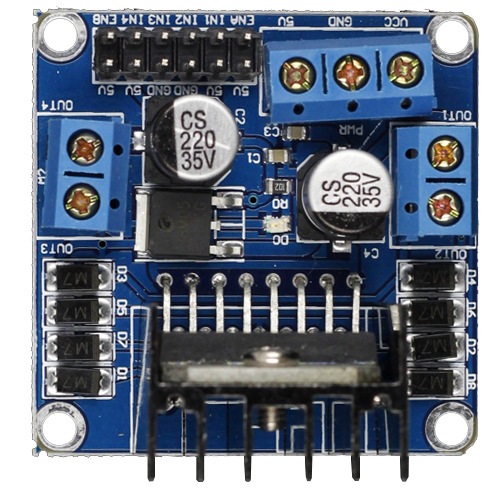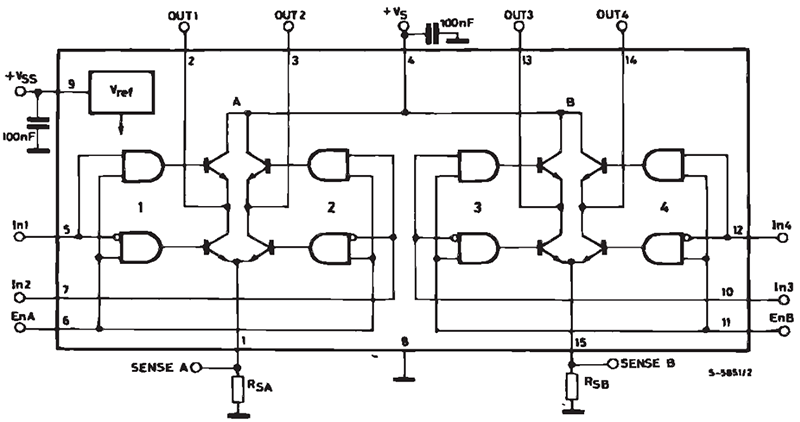Difference between revisions of "Motor Driver Module-L298N"
(Created page with "=='''Drecription'''== File:Motor1.JPG The L298N is an integrated monolithic circuit in a 15- lead Multiwatt and PowerSO20 packages. It is a high voltage , high current dua...") |
(→Resoures) |
||
| (8 intermediate revisions by the same user not shown) | |||
| Line 1: | Line 1: | ||
=='''Drecription'''== | =='''Drecription'''== | ||
| − | [[File:Motor1.JPG]] | + | [[File:Motor1.JPG]]<br> |
The L298N is an integrated monolithic circuit in a 15- lead Multiwatt and PowerSO20 packages. It is a high voltage , high current dual full-bridge driver de-signed to accept standard TTL logic level sand drive inductive loads such as relays, solenoids, DC and stepping motors. Two enable inputs are provided to enable or disable the device independently of the in-put signals .The emitters of the lower transistors of each bridge are connected together rand the corresponding external terminal can be used for the connection of an external sensing resistor. An additional Supply input is provided so that the logic works at a lower voltage.<br> | The L298N is an integrated monolithic circuit in a 15- lead Multiwatt and PowerSO20 packages. It is a high voltage , high current dual full-bridge driver de-signed to accept standard TTL logic level sand drive inductive loads such as relays, solenoids, DC and stepping motors. Two enable inputs are provided to enable or disable the device independently of the in-put signals .The emitters of the lower transistors of each bridge are connected together rand the corresponding external terminal can be used for the connection of an external sensing resistor. An additional Supply input is provided so that the logic works at a lower voltage.<br> | ||
Its schematic diagram is as shown in figure (a):<br> | Its schematic diagram is as shown in figure (a):<br> | ||
| − | [[File:Motor2.png]] | + | [[File:Motor2.png]]<br> |
(a)Schematic diagram for motor drive module<br> | (a)Schematic diagram for motor drive module<br> | ||
| Line 19: | Line 19: | ||
=='''Pin Function'''== | =='''Pin Function'''== | ||
| − | [[File:Motor3.png]] | + | [[File:Motor3.png]]<br> |
Its pin functions are as shown in table (1):<br> | Its pin functions are as shown in table (1):<br> | ||
| − | [[File:Motor4.png]] | + | [[File:Motor4.png]]<br> |
(1) Table for L298N pin functions<br> | (1) Table for L298N pin functions<br> | ||
=='''Principle'''== | =='''Principle'''== | ||
The driver module can drive two motors. The enabled terminals ENA and ENB are effective at high level. The control mode and state of motor A are as shown in table (2):<br> | The driver module can drive two motors. The enabled terminals ENA and ENB are effective at high level. The control mode and state of motor A are as shown in table (2):<br> | ||
| − | [[File:Motor5.png]] | + | [[File:Motor5.png]]<br> |
(2) Table for control mode and state of motor A<br> | (2) Table for control mode and state of motor A<br> | ||
If you want to regulate the speed of motor A by PWM, you need to set IN1 and IN2, confirm the rotational direction of the motor, and then output PWM pulses for enabled terminals. Please note the motor is in the free stop state when the signal of enabled terminal is 0. When the enabled signal is 1, if IN1 and IN2 are 00 or 11, the motor is in brake state, and the motor stops rotating. If IN1 is 0 and IN2 is 1, the motor A rotates clockwise; if IN1 is 1 and IN2 is 0, the motor A rotates counterclockwise. This is the control method for motor A. The control method for motor B is the same as that for motor A.<br> | If you want to regulate the speed of motor A by PWM, you need to set IN1 and IN2, confirm the rotational direction of the motor, and then output PWM pulses for enabled terminals. Please note the motor is in the free stop state when the signal of enabled terminal is 0. When the enabled signal is 1, if IN1 and IN2 are 00 or 11, the motor is in brake state, and the motor stops rotating. If IN1 is 0 and IN2 is 1, the motor A rotates clockwise; if IN1 is 1 and IN2 is 0, the motor A rotates counterclockwise. This is the control method for motor A. The control method for motor B is the same as that for motor A.<br> | ||
| + | |||
=='''Block Diagram'''== | =='''Block Diagram'''== | ||
[[File:Motor6.png]] | [[File:Motor6.png]] | ||
=='''Application'''== | =='''Application'''== | ||
The module can be applied to: | The module can be applied to: | ||
| − | - Drive DC motors. Since the module uses a dual H-bridge drive, it can drive two motors at the same time. | + | - Drive DC motors. Since the module uses a dual H-bridge drive, it can drive two motors at the same time.<br> |
| − | - Drive stepping motors. It can also drive two stepping motors synchronously. | + | - Drive stepping motors. It can also drive two stepping motors synchronously.<br> |
=='''Resoures'''== | =='''Resoures'''== | ||
| − | [http:// | + | [http://wiki.sunfounder.cc/images/a/ad/L298N.pdf L298N][[File:PDF.jpg]]<br> |
| + | [http://wiki.sunfounder.cc/images/b/bf/L298N_test_code.zip L298N_test_code for Arduino][[File:ZIP.jpg]] | ||
Latest revision as of 07:02, 20 March 2017
Contents
Drecription
The L298N is an integrated monolithic circuit in a 15- lead Multiwatt and PowerSO20 packages. It is a high voltage , high current dual full-bridge driver de-signed to accept standard TTL logic level sand drive inductive loads such as relays, solenoids, DC and stepping motors. Two enable inputs are provided to enable or disable the device independently of the in-put signals .The emitters of the lower transistors of each bridge are connected together rand the corresponding external terminal can be used for the connection of an external sensing resistor. An additional Supply input is provided so that the logic works at a lower voltage.
Its schematic diagram is as shown in figure (a):
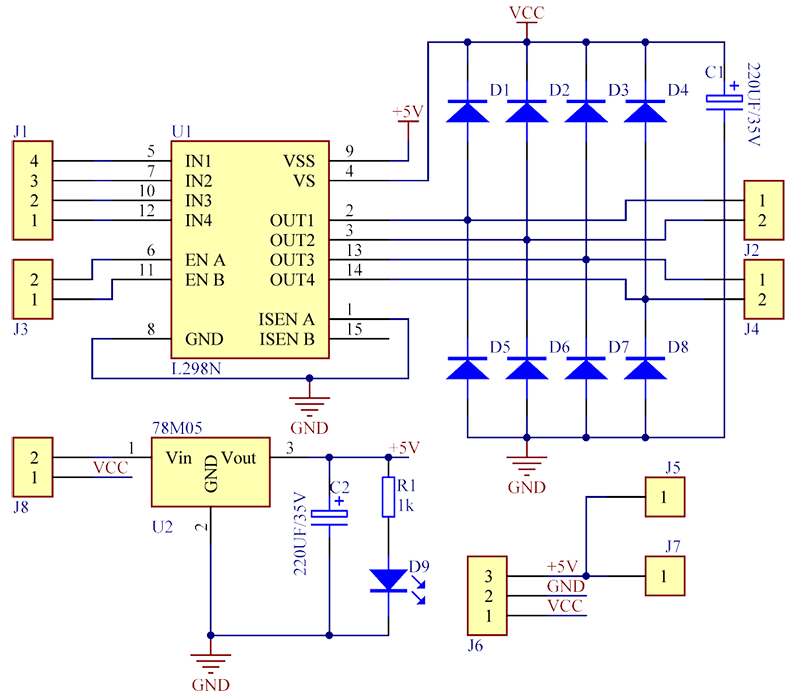
(a)Schematic diagram for motor drive module
Features
1) High operating voltage, which can be up to 40 volts;
2) Large output current, the instantaneous peak current can be up to 3A;
3) With 25W rated power;
4) Two built in H-bridge, high voltage, large current, full bridge driver, which can be used to drive DC motors, stepper motors, relay coils and other inductive loads.
5) Using standard logic level signal to control.
6) Able to drive a two-phase stepper motor or four-phase stepper motor, and two-phase DC motors.
7) Adopt a high-capacity filter capacitor and a freewheeling diode that protects devices in the circuit from being damaged by the reverse current of an inductive load, enhancing reliability
8) The module can utilize the built-in stabilivolt tube 78M05 to obtain 5v from the power supply. But to protect the chip of the 78M05 from damage, when the drive voltage is greater than 12v, an external 5v logic supply should be used.
9) Drive voltage: 5-35V; logic voltage: 5V
10) PCB size: 4.2 x 4.2 cm
Pin Function
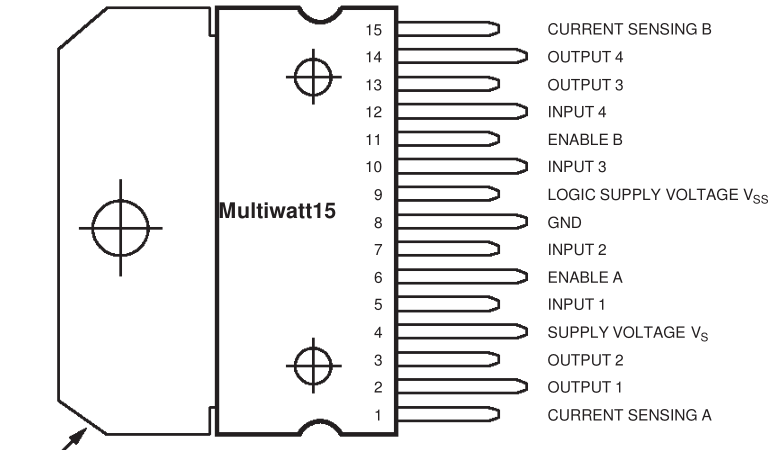
Its pin functions are as shown in table (1):
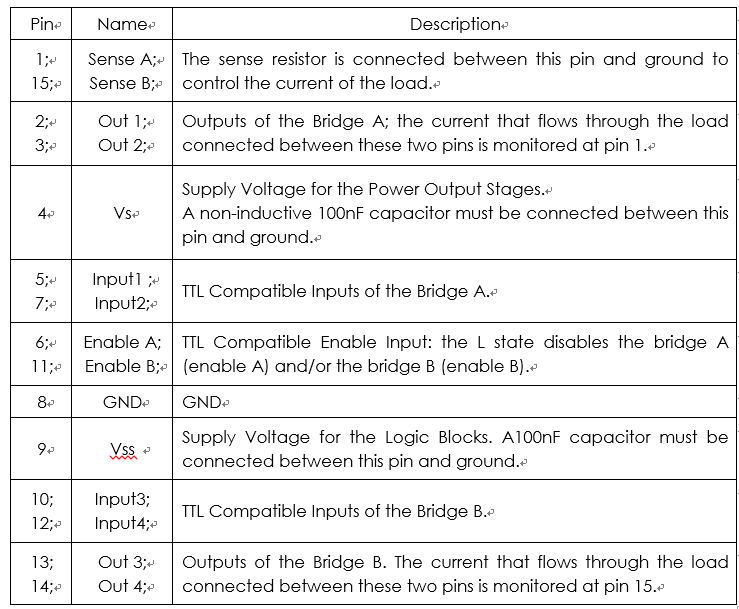
(1) Table for L298N pin functions
Principle
The driver module can drive two motors. The enabled terminals ENA and ENB are effective at high level. The control mode and state of motor A are as shown in table (2):
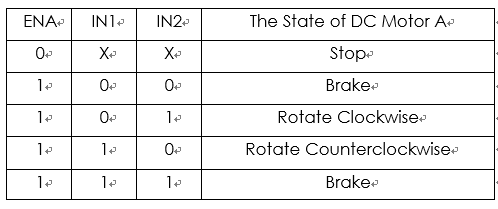
(2) Table for control mode and state of motor A
If you want to regulate the speed of motor A by PWM, you need to set IN1 and IN2, confirm the rotational direction of the motor, and then output PWM pulses for enabled terminals. Please note the motor is in the free stop state when the signal of enabled terminal is 0. When the enabled signal is 1, if IN1 and IN2 are 00 or 11, the motor is in brake state, and the motor stops rotating. If IN1 is 0 and IN2 is 1, the motor A rotates clockwise; if IN1 is 1 and IN2 is 0, the motor A rotates counterclockwise. This is the control method for motor A. The control method for motor B is the same as that for motor A.
Block Diagram
Application
The module can be applied to:
- Drive DC motors. Since the module uses a dual H-bridge drive, it can drive two motors at the same time.
- Drive stepping motors. It can also drive two stepping motors synchronously.
